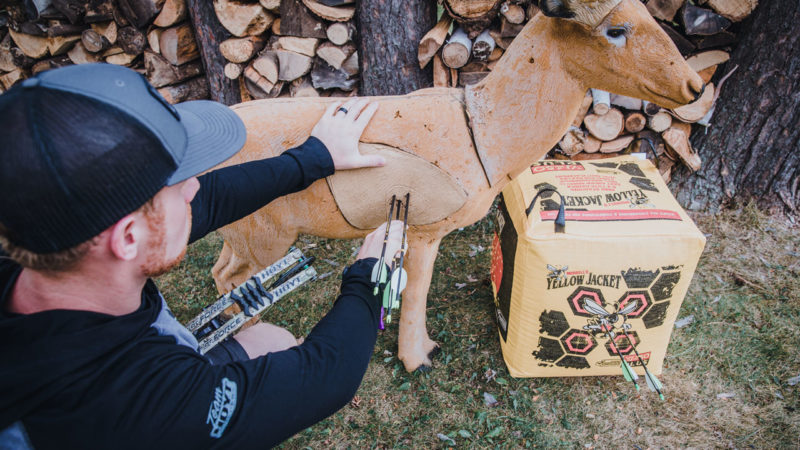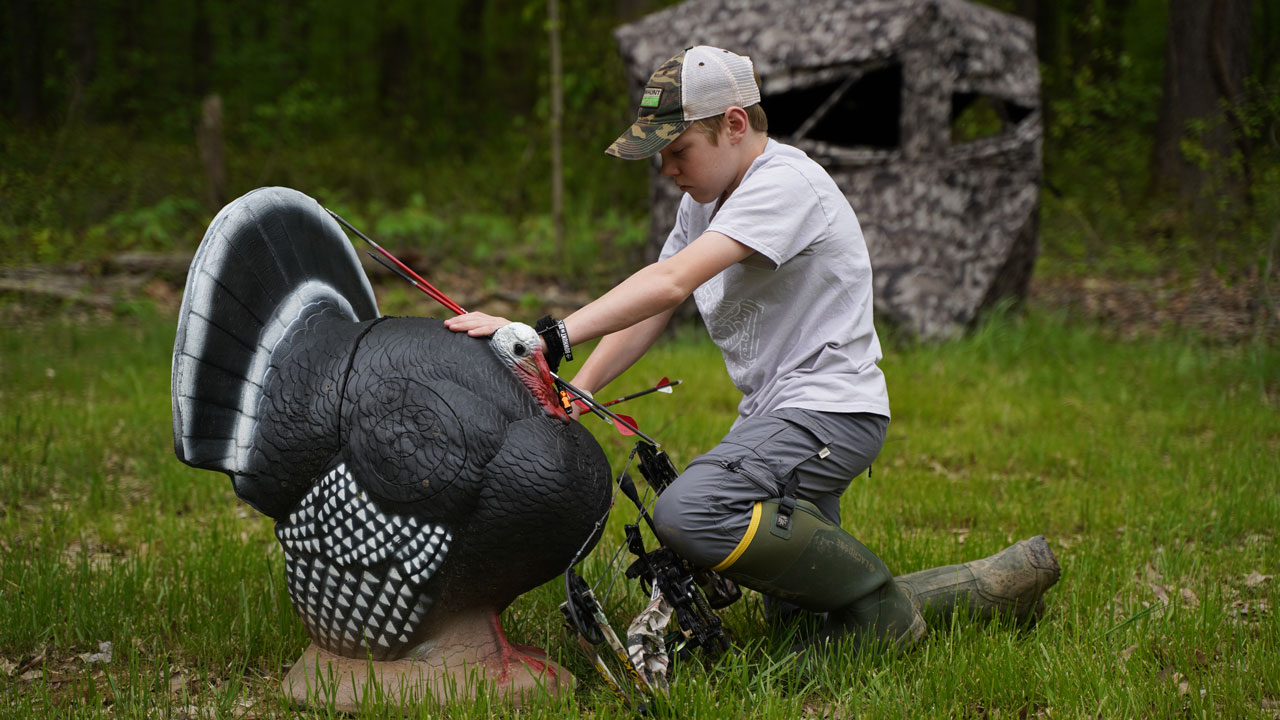Most die hard bowhunters have shot an occasional 3D course, however we often hear questions about what it takes to get better than the average Joe.

3D archery can be shot for many reasons by different people, from preparing for the woods all the way to the extreme of attempting to compete successfully at the state, regional, and national level.
What if you want to take 3D archery to the next step, where it really becomes a different pursuit than simply preparing you for the field?
The article is intended to be a road map to help those interested in becoming more competitive in 3D archery.
Classes and Rules
To start, you will need to determine what class you intend to compete in, and what rules will be enforced in the events you plan to attend.
Typically, you will see local events split into two separate classes; Bowhunter and Open.
Bowhunter classes are typically shooting from distances of 35-40 yards and closer. They will usually be restricted to some sort of pin sight that is not movable without the use of tools
Sometimes there will be rules on the number of pins allowed on the sight, most commonly restricting you to four of fewer pins, and you will normally not be allowed to use magnifying lenses on the sight.
Bowhunter class shooters will normally be restricted to stabilizers twelve inches or less, and will need to use arrows with screw in field points, and 4” or longer vanes or feathers on their arrows.
Open class shooters will normally shoot from distances of 50 yards and closer.
They will also be allowed to shoot any equipment that they desire as long as they stay within certain grain per pound of draw weight limits, or sometimes speed limits depending on what rules are being followed.
This is the class that your more experienced shooters will normally compete in.

Equipment
So what kind of equipment does it take to be successful in 3D archery? The first thing to consider is that a lot of the features that are an advantage when in a treestand, may not necessarily give you an advantage on the 3D course.
Once you know what class you want to compete in, you can then begin to build a list of the equipment that fits your needs and will give you the most competitive advantage within those rules.
For Bowhunter class 3D, speed really becomes much less critical than Open classes that shoot out past 40 yards.
When you look at the scores at the state, regional, and national level in Bowhunter classes, you will see that the best shooters will rarely shoot any 8’s on a course at all, usually hitting all 10’s and roughly half of the X rings available.
Mistakes and dropped points in this class usually occur due to poor shot execution, not because of distance judging errors.

At 40 yards and less, your margin for error on most targets will be +/- three to four yards. Knowing this, set your Bowhunter class rig up for consistency and forgiveness.
Top shooters in this class will typically shoot longer axle to axle bows in the 37” to 40” range, with forgiving brace heights of 7.5”+, and arrows going 280-290fps.
Because the top several places in most Bowhunter classes will only be separated by the number of X’s shot, give yourself an advantage and shoot the widest shaft that you can get to fly well and at an acceptable speed out of your bow.
Those wide shafts won’t be affected by the wind at the closer distances you will see in this class.
They will also help you grab some of those X ring lines that you normally would be just out on with a skinny hunting shaft.
For Open class 3D, good speed will typically be an advantage for the longer distances.
Those arrows drop fast out past 40 yards, and most of your shots will be in the 35-50 yard range.
Where allowed, most shooters in the top of this class will shoot bows shooting 290-320fps.
These are also typically shooters that are consistent enough in their shot execution that the less forgiving characteristics of the faster bows are rarely going to affect their overall performance.
Most shooters will be using adjustable worm-drive type sights with single pin scopes, and lenses that magnify with 2-4x powers being most popular.
They will also be using longer stabilizers to balance the bow neutrally and to slow their pin float.
Their arrows will normally be fletched with shorter lower profile vanes to prevent drifting in wind at the longer distances, and glue in points that are normally lighter than what is available with the inserts that the Bowhunter classes use.

What to practice?
There are 3 main components to shooting winning scores. Knowing where the X-ring is on that target, knowing the exact distance to the target, and executing a perfect shot.
Each of these components are equally important, and you will see top level shooters practicing each together in local 3D competition, but you also see them specifically training on each of these components independent of the others.
The good news, is that learning where the X-ring is and learning how to judge yardage are two things that can be accomplished at the same time.
The best way to do this, is to spend time looking at the actual targets.
When you speak to the top professionals that make a living in this sport, you will normally find that they practice judging distance and target details without a bow in their hands.
A great method that can be used is a walk on an existing 3D course, or even just a walk in the woods if you don’t have the targets available.
Bring a rangefinder, and a pad for yourself. Through your hike or walk on the course, pick random spots to judge distance from and feel free to stretch them out into the top end of what you will see in your class.
Judge the distance to the target first, then write down what you guessed.
A great method that can be used is a walk on an existing 3D course, or even just a walk in the woods if you don’t have the targets available. Bring a rangefinder, and a pad for yourself.
Through your hike or walk on the course, pick random spots to judge distance from and feel free to stretch them out into the top end of what you will see in your class.
Judge the distance to the target first, then write down what you guessed.
Range the object and then record the actual distance on your pad, and then move onto the next object or target.
After 30 objects, sit down and find the differences between your guessed and actual numbers for each object. If you were within one yard, give yourself a +1 for the target.
If you were within two or three yards, give yourself a 0.
If you were four to five yards off, give yourself a -2. If you were six to eight yards off, give yourself a -5. If you were 9 or more yards off, give yourself -10 points.
Keep training on this specifically, and if you spend time focusing on this part of your game specifically, it will show in your scores. This training will give you the ability to have confidence in your yardage judging ability, and this is one of the most important parts of the game.
Once you have picked a number, you need to be able to trust it so that you can focus 100% after this point on executing the perfect shot, and on the target detail that you need to reference to understand where that X-ring is.

Working on your shot execution is just as important as the yardage judging.
You need to train yourself on how to make a strong shot on each and every target under a variety of angles, footing, weather, and lighting conditions.
Spend the majority of your practice shooting the maximum distance you will see. Make sure that you can hit those chip shots as well, and if you’re shooting multiple pins, practice shots where you need to split pins and learn those gaps.
If you’re shooting at a 38 yard target, splitting your 30 and 40 yard pins isn’t going to put you in that X-ring. Learn where you need to shoot on those targets, and you will pick up points on the course where others are lucky to just hit a 10.
Wrap up
If you really want to get better at 3D, surround yourself with the best shooters you have in your area.
Most 3D shooters are friendly and eager to help and teach, and by pulling yourself out of your comfort zone and shooting with the best in your area, you will only get better.
Make sure you have fun with it as well, while it is quite rewarding to end up on the podium every Sunday it is also easy to burn out if you don’t make it fun.
If your not having fun, or not shooting well, put the bow away and come back another time. Last of all, make each arrow an honest and 100% focused attempt at improving your game, not just flinging arrows.
The main difference between the top shooters often comes down to their ability to focus on the small details and shoot each shot as if it was their first. Practice this way and you will see your scores climb.

Make sure to have fun!!!!





